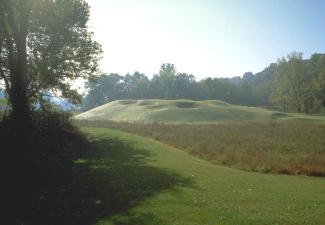Featured Golf News
Greens with No Backing Mounds
While the previous sections highlight some of the reasons many architects use mounds around greens, it is by no means universal, and repeating a similar theme on 18 greens isn't, in my opinion, productive.

While many people think all greens, tees or bunkers should be similar to create a "theme," one goal of golf architecture is to create 18 unique and memorable holes, which implies each hole and, especially, greens should have one different feature that sets it apart from the others.
Certainly, having greens with varying backdrop, with different mound types, or no mounds at all, can contribute to making each unique. Obviously, it is harder on a flat site and elevated green to add even higher mounds.
A good example of one type green which creates variety is the Platform or Fortress Green, defined as an elevated green, sloping away on all sides, as shown in this image of the course we designed for Opryland in Nashville.
The basic reasons to NOT design elevated or "perched" greens are:
• They effectively present a much smaller target of only the green surface and collar, about 6,000 to 9,000 square feet.
• Steep slopes around the green cause missed shots to carom well away from the green, potentially slowing play.
• Difficult to make ADA compliant with steep slopes all around.
• Potentially difficult (but not impossible) to get on green with specialized maintenance equipment.
Nonetheless, from time to time a perched or platform green is a good design solution.
In the case of the Opryland Course, the overall design need was to provide compensatory cut and fill to maintain flood levels of the adjacent Cumberland River, and to create some wetlands to mitigate other wetland losses, both required by environmental regulations.
We made this a short par-3 which, because of the difficulty of a platform green, is the best place to use this type of putting surface: a short-iron approach shot, and where multiple tees allow reasonable length for all players.
Jeffrey D. Brauer began his career as an apprentice in the Chicago area in 1977. His first project was Kemper Lakes, which shortly after hosted the 1989 PGA Championship. He formed GolfScapes in Arlington, Texas, in 1984. In the last 29 years he has designed and consulted on a wide spectrum of projects, ranging from partial renovations to international resorts. His recent work includes teaming with the design team of Pascuzzo and Pate on a remodel of the world-famous La Costa Resort & Spa in California, and renovations at Superior National Golf Course in Lutsen, Minn., and Mesquite Municipal Golf Course in Mesquite, Texas.
He has been a member of the American Society of Golf Course Architects since 1981, serving as President during its 50th Anniversary year in 1995-96. Jeff still studies the classic works - both old and new, and has played more than 75 of the best courses in the world.
Jeff gives many presentations and is a regular architecture columnist for many publications and websites, including Golf Course Industry and Cybergolf.com. He has also been a strong advocate for the "Tee it Forward" campaign and strives to make his courses fit the description of "fun to play every day."
Jeff's work has been spotlighted in most of the world's major golf magazines. Golf World ranked him as one of the top-20 golf course architects and Golf Inc. ranked him as the world's fourth-best value in golf architecture in 2010. Jeff's portfolio and reputation keep him at the forefront of desired designers for new courses, reconstruction and renovation projects. For more about Jeff, visit http://www.jeffreydbrauer.com/sites/courses/layout.asp?id=859&page=48451.
Story Options
 |
Print this Story |
